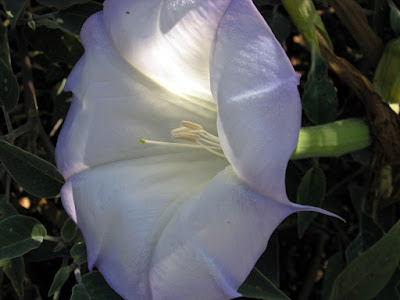Toloache
A plant of many names.
 |
| Toloache: photo by Cliff Hutson |
Datura wrightii
Datura, the name I first learned, is a member of the Nightshade family (Solanaceae) and is not uncommon from Central California to northern Mexico and east across the Southwest to Texas. It is, in fact fairly common in the foothills north of my home. So you may imagine my surprise that two of my field guides: "Introduction to California Chaparral" and "Introduction to the Plant Life of Southern California: Coast to Foothills" fail to mention it.
Perhaps this is due to the plant’s seedy reputation. Easily recognized by its trumpet-shaped flowers , it has been used for hundreds of years for its hallucinogenic properties. However, it is as toxic as it is narcotic and has been responsible for the deaths of some seeking to use it for its traditional religious purposes; or more likely, recreation.
Like many Americans of my generation, I first learned of the properties of Datura, also called Jimsonweed, through reading Carlos Castaneda’s "The Teachings of Don Juan". His purported experiences led many to go out and try it for themselves. Surprisingly, I never did.
I say surprisingly as I have gone through what I called a Euell Gibbons phase and have an abiding interest in ethnobotany, as evidenced by my work at Rancho Santa Ana Botanic Garden. These pursuits have led me to consume more than a few native plants of California. But, I have a healthy respect for for things that might kill me if I do not know what I am doing and figure to give Datura a permanent pass.
The book "California Indians and Their Environment: An Introduction" by Kent G. Lightfoot and Otis Parish has a few interesting entries on what they call Toloache. They describe religious uses, such as gaining the ability to transcend reality, and medicinal purposes. Some groups prepared it in a drink as a painkiller and a treatment for a variety of ailments.
Speaking of names, the "National Audubon Society Field Guide to North American Wildflowers" refers to the plant as Southwestern Thorn Apple. It says that the common name Jimsonweed is a corruption of Jamestown Weed. The story goes that it got the name when many soldiers sent to quell Bacon’s rebellion in 1676 were poisoned by it.
Jimsonweed
 |
| Jimsonweed: photo by Cliff Hutson |
By the way, the flower is typically white (see above), but may be some times tinged with violet, as shown in the lead photograph.
No comments:
Post a Comment